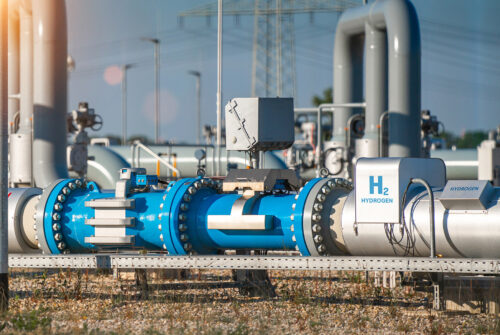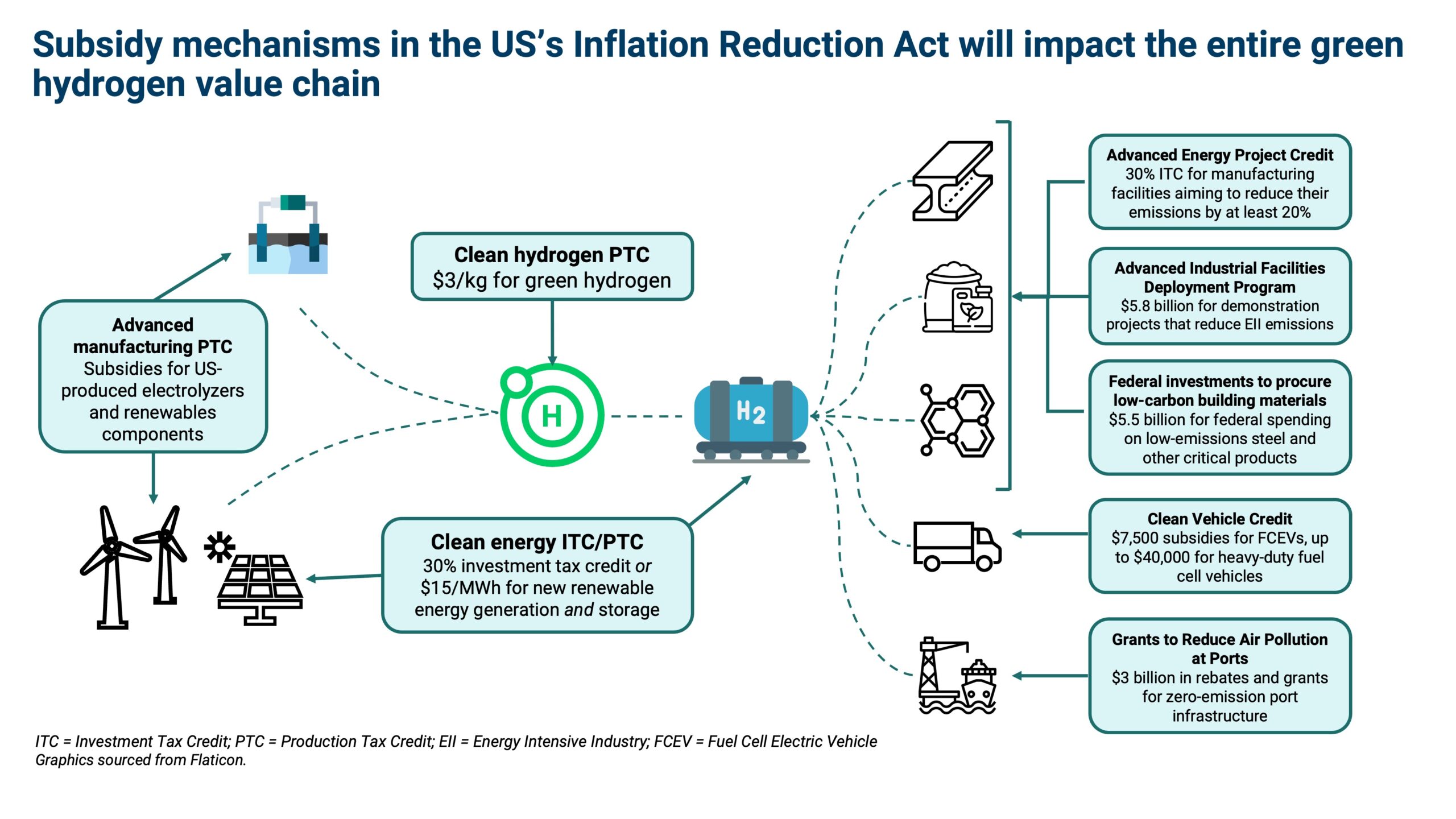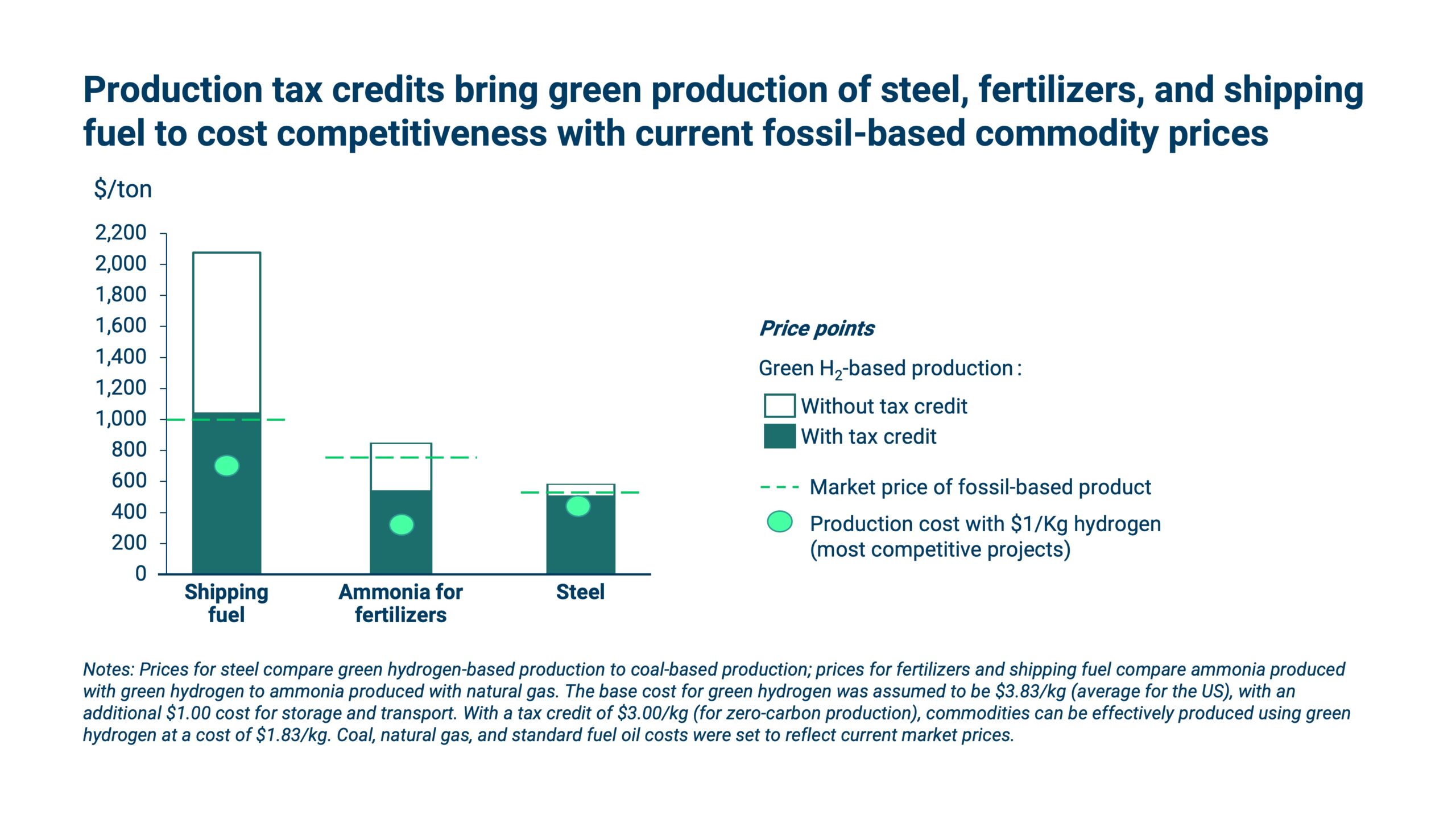
The Hydrogen Credit Catalyst
How US Treasury guidance on a new tax credit could shape the clean hydrogen economy, the future of American industry, and orient the power sector for full decarbonization.
A new tax credit to produce low-emission hydrogen could help bring critical technology to scale and create a vibrant economy of hydrogen production, purchase, and use, all while addressing one of our most challenging climate goals: slashing emissions from heavy industry. Clean hydrogen is necessary if we are going to decarbonize some of the most carbon-intensive parts of our economy — like shipping, aviation, trucking, fertilizer production, steelmaking, and chemical manufacturing. Just as we’ve seen with wind and solar, a tax incentive for low-carbon hydrogen can spur development of a low-cost, clean energy source.
Clean hydrogen production is already happening across the world. Industries are moving quickly to scale and use this technology. Thanks to a significant down payment on clean technologies of the future in the Inflation Reduction Act, US production of clean hydrogen will now receive a substantial tax credit that could unleash a torrent of production by making clean production competitive with current fossil production.
The potential value of the tax credit, combined with carefully constructed guidance and standards, could drive historic investment into production of the cleanest version of hydrogen. Moreover, it could support an energy transition focused on establishing a resilient, clean economy that we have been working to achieve for decades.
RMI believes thoughtful implementation of this tax credit can catalyze investment and deployment of clean energy generation in a way that also supports long-term economy-wide decarbonization. A granular emissions accounting system used to define low-carbon hydrogen for this tax credit, considering the complexities of our nation’s power grid and energy market economics, can lay the groundwork for long-term clean industrial growth that aligns with a 100 percent carbon-free grid of the future.
Why Climate-Aligned Implementation Is So Important
Already, many organizations, companies, and individuals, including RMI, have outlined the high stakes of the hydrogen tax credit—emphasizing how important it is to produce hydrogen in ways that reduce, not inadvertently increase, greenhouse gas (GHG) emissions.
One of the most economical and cleanest ways to produce hydrogen is via electrolysis directly powered by renewable energy sources. Projects connecting electrolyzers directly to solar panels, wind turbines, or geothermal energy will generate zero-emission hydrogen. These “behind-the-meter” systems (so-called because they bypass electricity grids) are straightforward candidates to receive the hydrogen production tax credit (PTC).
In contrast, projects that connect electrolyzers to existing power grids will generate hydrogen with the emissions intensity of that grid. The American power grid is still heavily powered by fossil fuel generators, and gas-fired power plants are often used to meet any additional demand on grid systems. It is therefore necessary to verify that grid-connected electrolyzers are effectively procuring renewable power — rather than fossil-based power — to produce clean hydrogen that merits a tax credit.
Our guidance in this policy brief is meant to advance the strategic implementation of the hydrogen tax credit — to incentivize the scaling of clean hydrogen using low-carbon electricity generation connected to the grid. Ultimately, this will help guide public and private investments in critical technologies, clean energy resources, and market infrastructure needed to support the clean grid of the future.
Three Key Elements Could Determine Hydrogen’s Success for Years to Come
The credit requires a standard that will ensure effective reduction of GHG emissions across all states for over twenty years. For “green” hydrogen produced with electrolyzers to qualify for the credit, producers will need to prove they are consuming between 90 to 97.5 percent of zero-carbon power. This will be simple for behind-the-meter systems, but more complicated for grid-connected systems. There are three key principles that, if put in place for grid-connected projects, would ensure low emissions across geography and time: additionality; granular and emissions-accurate accounting; and deliverability. All three of these principles need to be met for producers to confidently demonstrate low-carbon, grid-connected hydrogen production and qualify for the credit.
Let us break down what that means:
Additionality: The grid reacts to new demand (in this case, a new hydrogen electrolyzer) with increased generation. Hydrogen producers must be responsible for ensuring that their added demand is met with new and low-carbon generation. If producers are not responsible for procuring new clean power, electrolyzers could functionally consume clean power from the grid that would otherwise decarbonize sectors like transportation and buildings, while carbon-intensive power backfills the pre-existing demand in those sectors.
Emissions-accurate temporal accounting: The US Treasury Department will need to decide at what temporal granularity clean power supply will be needed to match demand from grid-connected electrolyzers. This could be hourly, daily, weekly, quarterly, annually, or some other timeframe. However, because the hydrogen PTC is an emissions-based credit, the granularity chosen should reflect the most feasible, emissions-accurate timeframe.
Given that marginal emissions on every grid differ from hour to hour, day to day, week to week, and so on, when clean generation and increased demand from hydrogen production are not aligned, there will be emissions induced. For example, a solar heavy grid will have low-carbon intensity in the middle of the day, so if a hydrogen producer is procuring clean energy but is not aligned during those hours there may not be significant emissions impacts. But consider that same grid at night when solar is not generating. If a hydrogen producer is drawing power while the grid is primarily calling on carbon-intensive resources, without supplying new low-carbon generation, it will result in a much higher emissions rate.
Accurate data for these interactions is critical, but often difficult to access due to hard-to-predict utility dispatch decisions. On the other hand, an energy matching system that balances produced and consumed electricity is more predictable and controllable.
Therefore, a temporal matching structure, such that over the given time period all demand from the electrolyzer will be matched with supply from clean generation, must be established so that the emissions impacts are as close as possible to a perfectly measured emissions system. A paper from UC Davis found that annual tracking, for example, can underestimate the real emissions impact of grid-connected electrolyzers by up to 35 percent. The more granular the matching window, the more likely the clean generation will be deployed and supply power in a way that prevents the hydrogen production demand from inducing emissions from the power sector.
Deliverability: Clean power is only as good as its ability to get to where it is needed. Therefore, any additional, temporally matched clean power must also prove it can be delivered to where the hydrogen project sits. That means it is free of congestion and able to connect low-carbon electrons to the electrolyzer itself. Without deliverability, new and hourly accounted power could be oversaturating a separate market, and the hydrogen electrolyzer will still have to draw on carbon-intensive power.
Setting standards on grid-connected electrolyzers will ensure the hydrogen production tax credit is distributed effectively and efficiently, ensuring the long-term success of the hydrogen economy and its associated clean energy and manufacturing jobs. As American industries embrace decarbonization, Treasury should ensure the standards in place provide certainty that the hydrogen produced and used is truly low carbon.
Why So Much Interest in This Specific Tax Credit?
The implementation of tax credits has long been a significant driver in the widespread adoption of clean energy technologies. However, the hydrogen tax credit standards are particularly important because, if distributed effectively, the credit could create ripple effects far beyond the important end goals of hydrogen production and industrial decarbonization. If implemented thoughtfully, this credit could drive investment in clean technologies of the future (think geothermal and long duration storage), steer international standards for clean commodities like steel and fertilizer, and reestablish the United States as a manufacturing giant by revitalizing and supporting clean industrial communities across the nation.
It is a massive investment — with the potential to grow. This credit could immediately cut the cost of producing low-carbon hydrogen and make it competitive with carbon-intensive hydrogen production, like with unabated natural gas. The tax credit can pay out as much as $3 per kilogram of clean hydrogen produced over ten years, awarding projects developed as late as January 1, 2033. In addition, the direct pay nature of this tax credit enables industries to apply without “tax equity” — a provision that should help alleviate constraints in the tax equity market and remove a barrier for many producers.
It could kickstart the next generation of emissions accounting. These standards could catalyze more granular grid emissions accounting — which is required to understand where exactly the energy used to produce hydrogen is coming from, and how dirty or clean that energy is, in a very precise way. Establishing clear principles in this rulemaking could influence and support the ongoing voluntary emissions accounting process used by so many governments and companies worldwide. This credit could support the development of the market infrastructure needed to establish a more accurate emissions accounting system. Anyone interested in renewable procurement and scope 2 emissions accounting should be paying close attention.
It could pay for rapid and smart grid decarbonization. Traditional power sector economics will be drastically altered by the introduction of incentives to produce hydrogen. Given the unprecedented scale of this tax credit, it’s going to make economic sense to produce hydrogen in volumes never seen before and at times it otherwise would not make economic sense given fluctuating power prices. We can safely assume Treasury will release regulations that govern grid-connected electrolyzers; they may even look to the European Union who recently released their own standards incorporating these three pillars. However, the stringency of Treasury’s guidance will shape what clean power is built, where it is built, and what times it generates and adds power to the grid. The hydrogen PTC is a useful carrot to help incentivize clean energy deployment that contributes to a fully decarbonized grid of the future, rather than complicates it.
If implemented with the three pillars described above, hydrogen producers will be incentivized — and paid via the production tax credit — to site their electrolyzers and their clean generation in ways that support broader grid decarbonization and flexibility. Solar will be added where hourly solar generation is lacking, wind will be built where nighttime demands and emissions are high, and storage can be sited when and where it makes the most sense. Market signals will also drive investment and deployment of clean firm generation such as enhanced geothermal, something our grid will need to rely on to achieve full decarbonization.
It is critical and possible to guide these incentives so that efficient grid decarbonization is harmonized with hydrogen production. Power sector experts should be teaming up with hydrogen experts to understand how this production tax credit will change the landscape of the grid, for better or for worse.
It can be world changing. Hydrogen is going to be used as a solution throughout the world. Synthesizing strong standards and creating transparent markets will be a top priority for nations hoping to participate in the international clean energy economy. Setting smart standards for the world’s biggest hydrogen subsidy here in the United States puts us at the head of the table as the international hydrogen market conversations develop.
What a Wonderful, Decarbonized World: The Future of Clean Hydrogen and American Industry
How Treasury decides to implement this tax credit will shape hydrogen systems and the industries using hydrogen for a long time. Large-scale projects are coming, and private industry is watching this process closely to see how they can take advantage of the financial incentives that will help them make their projects a reality. We should set effective standards from the outset, to ensure that project developers receive clear signals and neutralize the threat of long-term regulatory uncertainty.
Should qualification for the hydrogen production tax credit require producers to invest in new, local renewable power combined with flexibility to match load and demand now, producers will be set up for long-term success. They will have access to zero-cost wind and solar energy, be practiced in storage and electrolyzer ramping management strategies needed to match power on an emissions-accurate, granular temporal basis, and will be co-located to the power “supplying” their production in a way that guarantees they continue to produce clean hydrogen at low costs. In short, the hydrogen tax credit regulations will set producers up for long-term success and reward them for prioritizing long-term decarbonization. The steel plants, fertilizer production facilities, chemical processing plants, aviation fuel processors, and ships that rely on the production of this clean hydrogen will be able to count on these grid-connected electrolyzers producing long into the future, providing critical certainty in a global market where clean hydrogen-based commodities will rule the day.
New clean fertilizer production plants powered by hydrogen could support American agriculture and rural economies while helping tackle global hunger amid a food crisis. Clean hydrogen can help revive the legacy of American steelmaking by establishing low-carbon manufacturing hubs — giving workers a pathway in our energy transition and bringing revenue to regions that have suffered divestment in recent decades. The ripple effects of these certainties and sustainable growth will help families and communities thrive in a new clean energy economy.
This vision of the future hinges on the standards we establish today.

